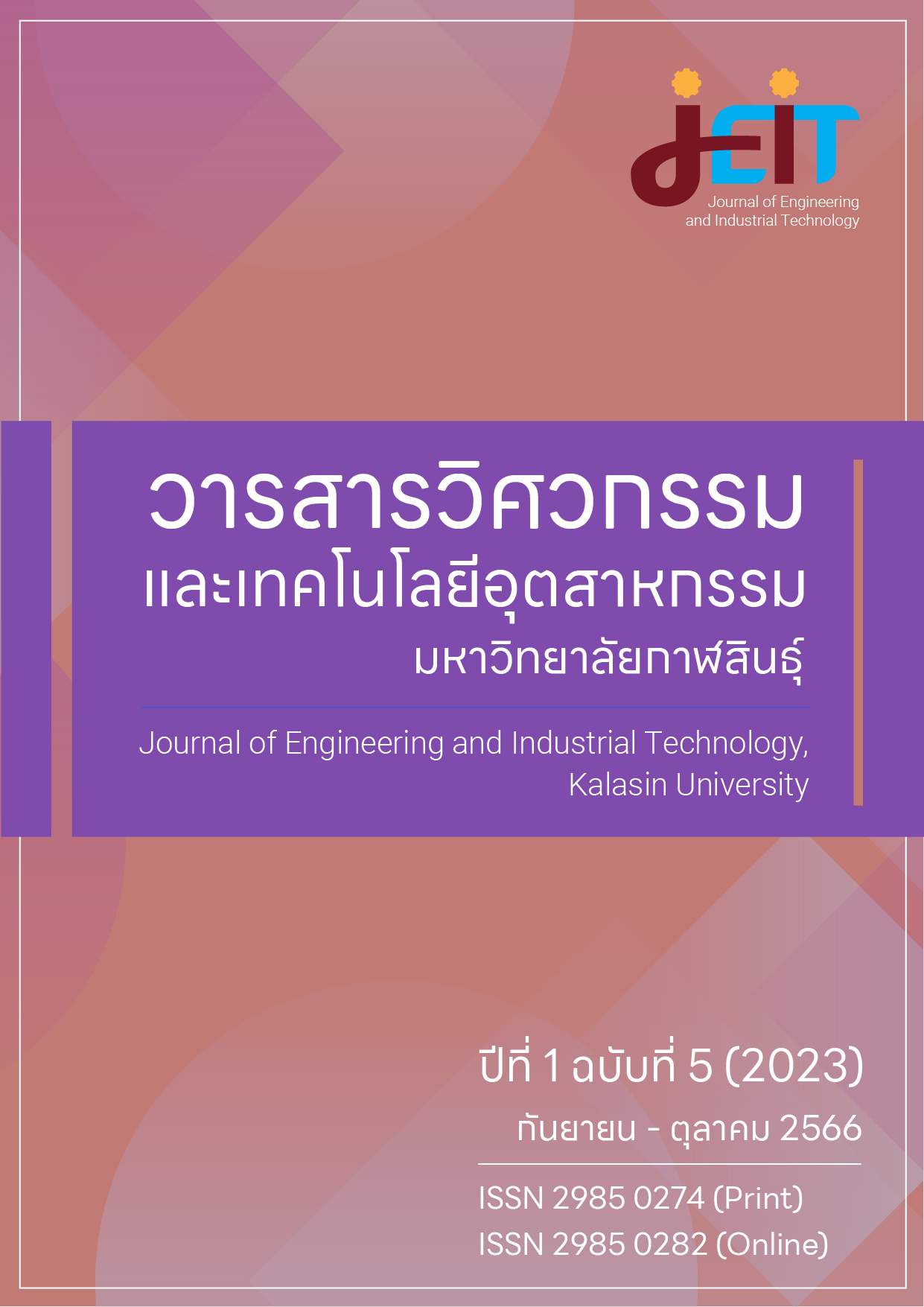A Study on Thermal Properties of Mangosteen Wood Briquette mixed with Carbon Black
DOI:
https://doi.org/10.14456/jeit.2023.19Keywords:
Mangosteen Briquette, Carbon black, Heating value, Moisture and Ash ContentAbstract
The objective of this research was to study the calorific value, moisture content, and ash content of briquettes produced from mangosteen charcoal combined with carbon black in quantities of 20, 30, and 40 grams. Carbon black was mixed with 3.0 kilograms of finely ground mangosteen charcoal, using 0.25 kilograms of tapioca starch and 2.0 liters of water as a binder. The briquettes were then compressed using a cold press method. The thermal properties were then studied according to ASTM standards. The results showed that increasing the amount of carbon black in the mangosteen charcoal briquettes resulted in an increase in calorific value, but a decrease in moisture content and ash content. The briquettes with and without carbon black had calorific values of 25,477 ± 237 and 25,699 ± 124 kJ/kg, respectively. These values were higher than the standard value for community-produced briquettes 238/2547. The briquettes with various amounts of carbon black had moisture content and ash content of 9.44 ± 0.86%, 6.94 ± 0.31%, 9.10 ± 0.79%, and 3.88 ± 0.23%, respectively. These values were lower than the standard values for community-produced charcoal 657/2547, which specify moisture content and ash content of no more than 10% and 8.0%, respectively. In conclusion, the addition of carbon black to mangosteen charcoal briquettes can improve the thermal properties, making them a more efficient fuel source. However, adding too much carbon black can make the briquettes too dense, which can make them brittle. Therefore, further research is needed to determine the optimal amount of carbon black to improve the thermal properties of mangosteen charcoal briquettes.
References
[1] สำนักงานเศรษฐกิจการเกษตร, "สถิติการเกษตรของประเทศไทย," กระทรวงเกษตรและสหกรณ์, 2561.
[2] ธเนศ ไชยชนะ, จอมภพ แววศักดิ์, จตุพร แก้วอ่อน, และ อุษา อ้นทอง รุ่งโรจน์, "สมบัติความเป็นเชื้อเพลิงของถ่านเปลือกมังคุด," วารสารมหาวิทยาลัยทักษิณ, ปีที่ 17, ฉบับที่ 3, หน้า 29–36, 2557.
[3] กานต์ วิรุณพันธ์, ธนารักษ์ สายเปลี่ยน, และ ภาคภูมิ ใจชมพู, "การผลิตเชื้อเพลิงถ่านอัดแท่งจากเศษวัสดุเหลือใช้ในการผลิตข้าวหลาม," วารสารวิศวกรรมศาสตร์มหาวิทยาลัยเทคโนโลยีราชมงคลล้านนา, ปีที่ 2, ฉบับที่ 1, หน้า 1-15, 2560.
[4] วัชราภรณ์ ยุบลเขต และ ดาริวรรณ เศรษฐีธรรม, "เปรียบเทียบสมบัติของเชื้อเพลิงอัดแท่งจากเศษขยะใบไม้ที่ได้จากการอัดด้วยเครื่องอัดและอัดด้วยมือ," วารสารมหาวิทยาลัยขอนแก่น. (ฉบับบัณฑิตศึกษา), ปีที่ 17, ฉบับที่ 4, หน้า 85-96, 2560.
[5] C. Thassana and W. Nuleg, "Effect of carbon black on thermal properties of charcoal and salacca leafstalk briquettes," in AIP Conference Proceedings 1868, 2017, pp. 060002-1-060002-5.
Downloads
Published
How to Cite
Issue
Section
Categories
License
Copyright (c) 2023 Journal of Engineering and Industrial Technology, Kalasin University

This work is licensed under a Creative Commons Attribution-NonCommercial-NoDerivatives 4.0 International License.
ลิขสิทธิ์ของวารสาร
เนื้อหาและข้อมูลในบทความที่ลงตีพิมพ์ในวารสารศูนย์ดัชนีการอ้างอิงวารสารไทย ถือเป็นข้อคิดเห็นและความรับผิดชอบของผู้เขียนบทความโดยตรงซึ่งกองบรรณาธิการวารสาร ไม่จำเป็นต้องเห็นด้วย หรือร่วมรับผิดชอบใด ๆ
บทความ ข้อมูล เนื้อหา รูปภาพ ฯลฯ ที่ได้รับการตีพิมพ์ในวารสารศูนย์ดัชนีการอ้างอิงวารสารไทย ถือเป็นลิขสิทธิ์ของวารสารศูนย์ดัชนีการอ้างอิงวารสารไทย หากบุคคลหรือหน่วยงานใดต้องการนำทั้งหมดหรือส่วนหนึ่งส่วนใดไปเผยแพร่ต่อหรือเพื่อกระทำการใด จะต้องได้รับอนุญาตเป็นลายลักอักษรจากวารสารศูนย์ดัชนีการอ้างอิงวารสารไทยก่อนเท่านั้น


